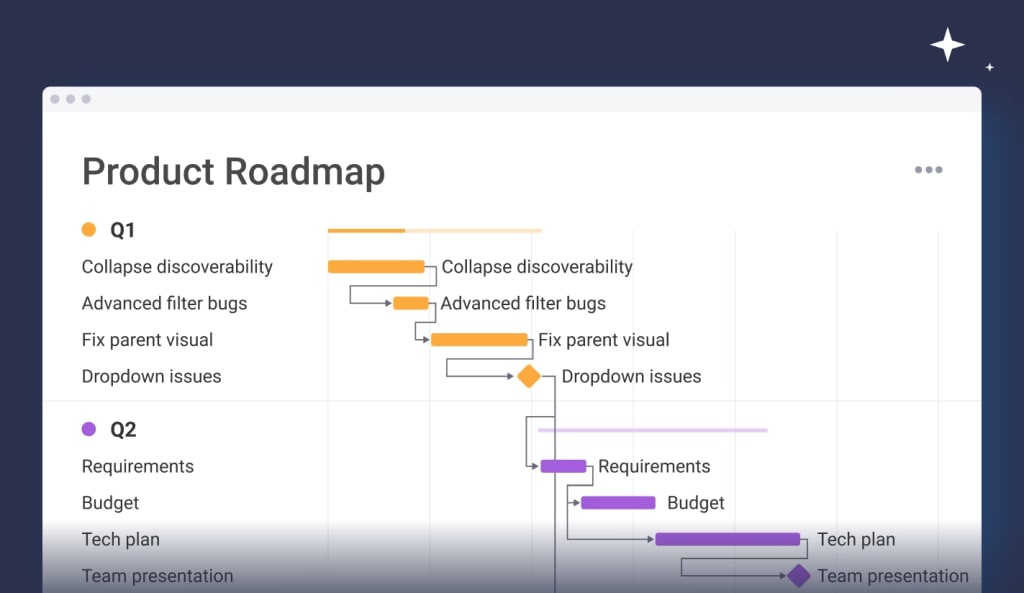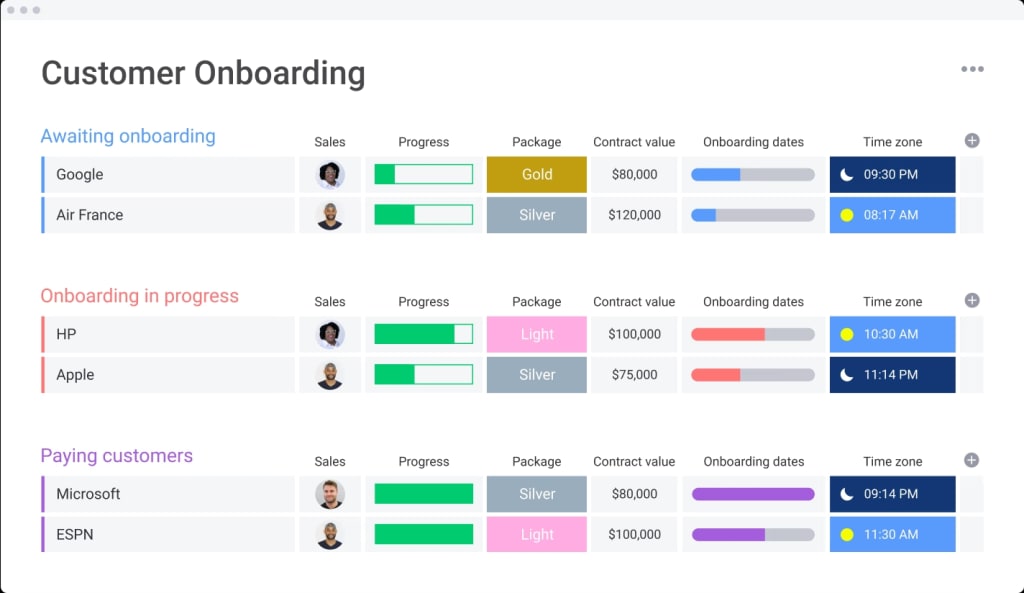Customers come and go — it’s just a fact of life. But keeping your customers happy and reducing your customer attrition rate is a surefire way to boost revenue and profits.
So, what exactly is customer attrition and how do you minimize it?
In this guide, we’ll define customer attrition, show you how to calculate it, and explain why it’s an important business metric. Plus, we’ll share how to reduce customer attrition and show you how to manage it with monday.com — we’ll even include three of our customizable templates to get you started.
What is customer attrition?
Customer attrition, also known as customer churn, defection, or turnover, refers to the loss of a customer. Even though most customers don’t remain active indefinitely, you should still take steps to retain them.
Customer retention is the opposite of customer attrition. For every customer you retain, that’s one less you’ve lost.
You can minimize customer attrition and keep your company growing by implementing an effective customer relationship management and retention strategy.
Voluntary vs. involuntary attrition
Customer attrition falls into two separate categories:
- Voluntary attrition is when a customer chooses to end the relationship of their own accord.
- Involuntary attrition is caused by a failed payment attempt, resulting in a subscription cancellation.
When analyzing customer attrition, most companies only consider voluntary attrition.
Active and passive customer attrition
Two more related terms are active and passive attrition.
- Active attrition refers to a customer who cancels their subscription, for example, to an app or streaming service.
- Passive attrition refers to a customer who stops transacting with a business, for example, a retail or e-commerce store.
It’s easier for customer retention experts to reduce active attrition since they can offer incentives like lower subscriptions or free add-ons. But detecting “churn signals” before the customer leaves makes passive attrition challenging.
How to calculate customer attrition rate
Customer attrition rate is expressed as a percentage.
You calculate it by dividing the number of customers lost within a period by the total number of customers at the beginning of the period, and multiplying by 100. Here’s the formula:
Customer Attrition Rate = (Number of Customers Lost / Total Number of Customers) x 100
For example, if you had 500 customers at the start of the month and 25 of them left, then:
Customer Attrition Rate = (25 / 500) x 100 = 5%
In other words, 5% of your total customers left during the given period.
Why is customer attrition an important metric?
Customer attrition is a key performance indicator (KPI) that companies track to ensure they make the right strategic decisions. It provides critical insights into the company offerings’ strengths, weaknesses, and opportunities. A high attrition rate indicates a severe problem that needs addressing, such as product or service defects, poor customer service, or inadequate value.
- Customer attrition damages brand reputation. Lost customers are more likely to share their negative experiences publicly on social media and review sites as well as with friends and family. One negative review can outweigh a dozen positive ones.
- Customer attrition causes revenue loss. You lose immediate and future revenue from lost customers, including renewals and upsells. Furthermore, if they’re using other products from your company, they are likely to seek alternatives.
- Customer attrition reduces profit margins. Retaining an existing customer is far less expensive than acquiring a new one. If new customers primarily drive your revenue growth, customer acquisition costs will chip away at your profits.
How to reduce customer attrition
Here are five ways to reduce customer attrition.
1. Enhance your product or service offering
The best way to reduce attrition is to ensure your product or service is top quality.
- Does it meet the needs of your customers?
- Is it better than the competition?
- Is it priced correctly?
Ensure you’re creating the best product or service to attract and retain customers.
2. Target the right customers
Customers may leave because they’re not the best fit for your brand. Some customers place a different value on your products than others. Although targeting as many customers as possible is tempting, it’s much better to acquire the right type of customers for the long term.
Latest figures show 91% of businesses with over 11 employees now use some form of CRM. With 74% of them saying that their CRM makes customer data more accessible.
3. Provide better customer experience/service
Customers expect a top-notch experience and service level when interacting with your brand.
- Is the purchasing process smooth?
- Can they find all the relevant details about your policies and offerings?
- Do you have a good customer service/support team?
These factors all play a role in customer attrition.
4. Improve customer marketing
You need to communicate with each existing customer in a highly personalized manner, using the channels, messages, and frequency that work best for them. The one-size-fits-all approach to customer marketing doesn’t work. Rather than wasting their time with irrelevant, annoying communications, customers expect brands to understand them, their preferences, and their needs.
5. Predict customer attrition
You can analyze existing customer data to spot behaviors and trends, and determine the most effective strategy, such as lower subscriptions or free add-ons, to prevent them from leaving. Successfully predicting customer attrition – and proactively preventing it – can add significant revenue to most businesses.
How to manage customer attrition on monday.com
With the monday sales CRM, you can drive revenue growth through increased customer retention, which helps reduce your customer attrition rate.
You can store all of your customer details and valuable insights, plus get automated reminders when to follow-up with them. With everything stored on the CRM dashboard, your team will always have all essential customer information at their fingertips.
Here are three ready-made templates you can use to minimize customer attrition.
Visualize your work with the product roadmap template
The best way to reduce customer attrition is by creating the best available product to attract and retain customers. The Product Roadmap template creates a visual timeline of all your product releases and goals so you deliver top-quality products on time. Save time by automating your routine work with real-time notifications when completing tasks.

Guarantee success with the customer onboarding template
Another way to reduce customer attrition is to ensure you have a frictionless onboarding process so that users quickly adopt your product or service. Manage the entire customer onboarding process, from the kick-off meeting to implementation and training with the Customer Onboarding template. Keep track of the onboarding process, measure the time invested, and keep everyone aligned.

Boost satisfaction with the customer support template
Providing excellent customer service is critical to minimizing attrition rates. Manage all incoming customer support requests in one place and boost customer satisfaction with the Customer Requests template. Maintain an efficient team with essential, in-context resources and updates within the customer support workflow.

Whatever template you choose, monday.com lets you:
- Customize your workflows from due dates to status columns.
- Visualize your work with calendars, timelines, kanban, and Gantt views.
- Centralize all your work inside monday.com, like syncing due dates with your Google Calendar.
Frequently asked questions
Here are three frequently asked questions about customer attrition.
What is a reasonable customer attrition rate?
Ideally, you’d have no customer attrition, but that’s almost impossible, as customer churn is inevitable. The average churn rate is 21%. But the safest bet is to stay above the industry average:
- Financial/Credit: 25%
- Cable: 25%
- General Retail: 24%
- Online Retail22%
- Telecom/Wireless: 21%
- Travel: 18%
- Big Box Electronics: 11%
On the flip side, the average customer retention rate of the top five companies is around 94%. And the average customer retention rate by industry is:
- Insurance: 84%
- Retail: 63%
- Banking: 75%
- SaaS: 35%
- Hospitality: 55%
- Media: 25%
- Fintech: 37%
- Edtech: 4%
How do you measure customer attrition?
Customer attrition is measured as a percentage. Here’s the formula:
Customer Attrition Rate = (Number of Customers Lost / Total Number of Customers) x 100
What causes customer attrition?
Here are the most common causes of customer attrition:
- Undefined USP
- Wrong targeting and customer fit
- Inadequate onboarding procedures/friction
- Multiple unresolved product glitches
- Misaligned pricing strategy
- Poor customer support service
- Poor end-to-end customer experience
Minimize customer attrition with monday.com
Sure, losing customers is inevitable, but you can see the strengths, weaknesses, and opportunities within your company offerings by analyzing your customer attrition data. You can reduce churn by enhancing your product or service offerings, targeting the right customers, and providing a better crm experience.
Try monday.com to see how easy it is to plan, track, and view product roadmaps, customer onboarding or customer support requests and minimize attrition.

